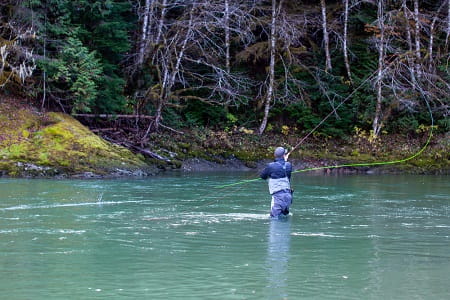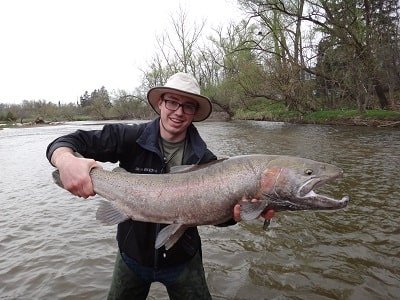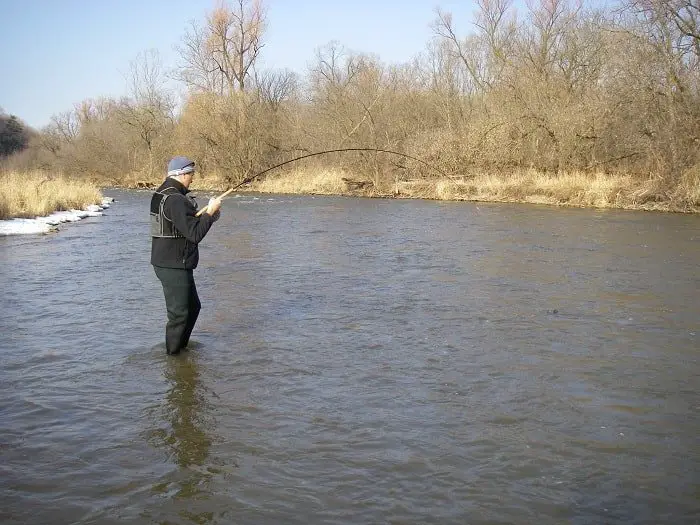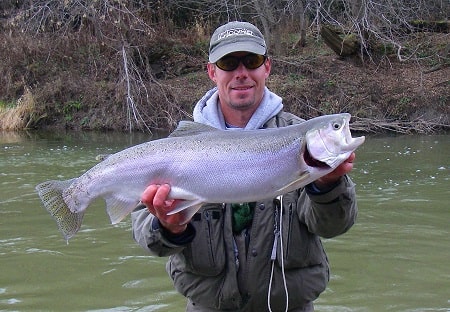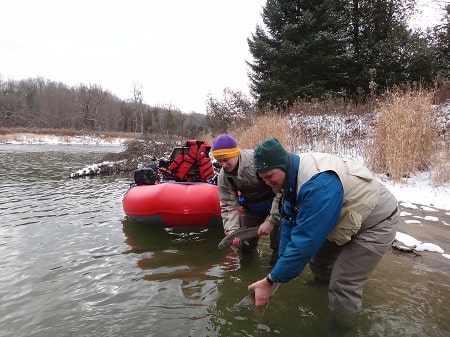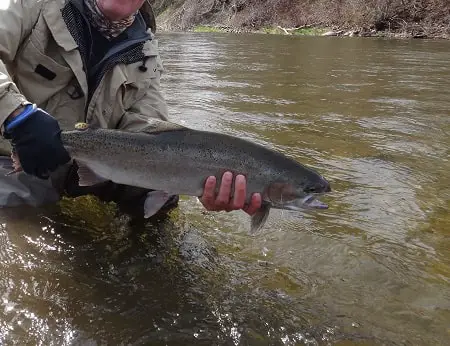Streamer Fishing For Steelhead: GUIDE SECRETS
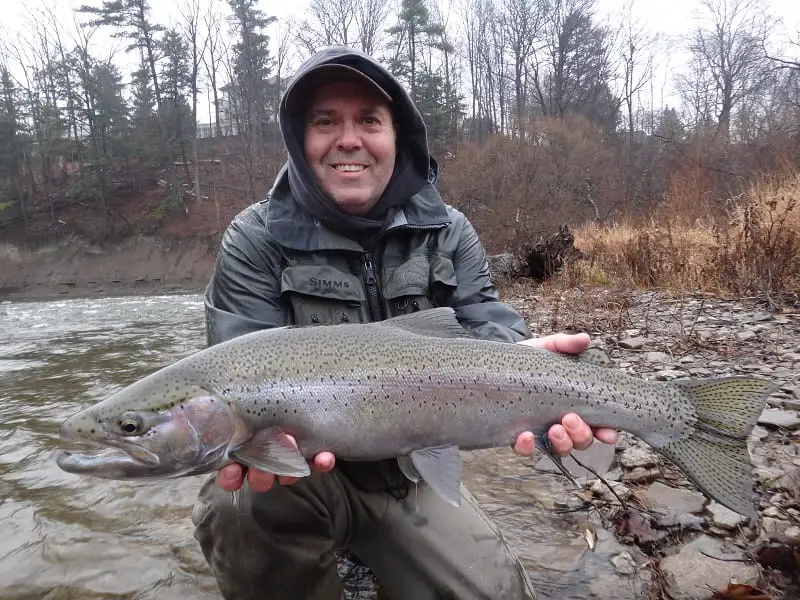
Streamer fishing for steelhead is a fun and effective way to fish for steelhead in rivers. River guides like myself and those on our guide team use certain streamer flies and some unique methods that are very effective when fishing for steelhead with streamer patterns.
Streamer fishing is when you cast and then retrieve large baitfish-looking streamer flies to aggressive steelhead that are looking for baitfish to eat. Steelhead fishing with a streamer in rivers can mean hard exciting hits from many big steelhead.
Streamer Fishing For Steelhead
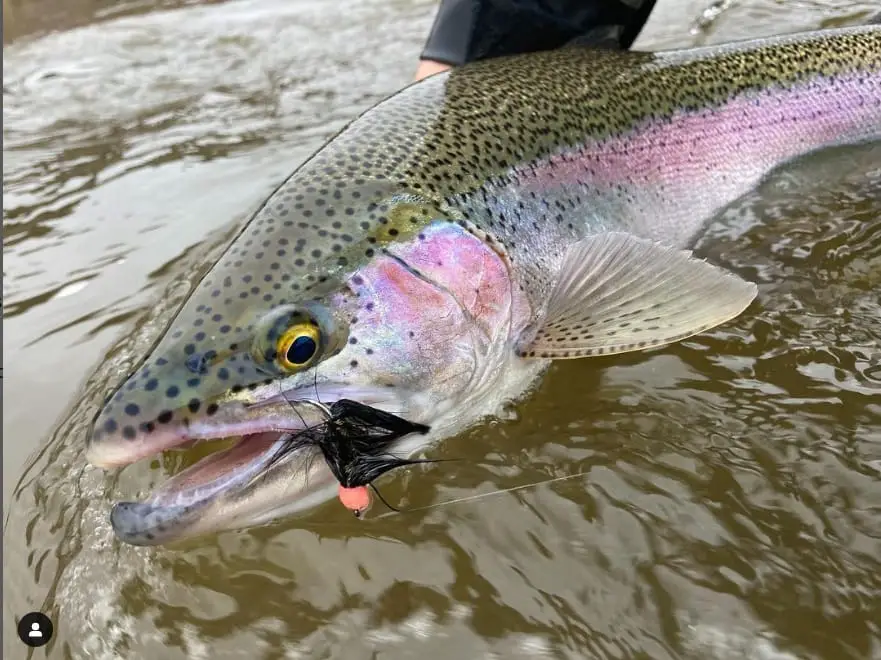
Streamer fishing is one of four fly fishing methods that I recommend to anglers on my page Fly Fishing For Steelhead.
This method often takes the back seat to other fly fishing methods like nymphing, but it can be very effective if it’s done well.
Many guys either find it difficult or ineffective, but there are ways to make it easier and more effective.
Catching steelhead on streamers is also exciting since anglers can be rewarded with hard aggressive hits that sometimes feel like the rod is going to be ripped out of their hands. They might even get lucky and see a steelhead chase down and swipe at their streamer fly.
I find that a steelhead that misses or refuses your nymph when nymph fishing will sometimes smash a well-presented streamer fly. The keyword there is “well presented.” This is why I will often do both streamer fishing and nymphing in the same spots and I do them back to back.
I will often nymph first and then streamer fish second, but there are times when it seems they are more interested in the streamer, and I will start with that first, or only fish with streamers if they keep grabbing them.
Casting those heavier lines and bigger flies over and over can be a lot of work. But using the right rod, the right line, and the right leader can make streamer fishing much easier. I will discuss the proper fly fishing gear below.
Also, I will provide you with a much easier way to cast so you can cover water faster with less work. I teach anglers how to do this in my advanced streamer fishing classes.
Learning to limit your backcasts is the key to doing less work when streamer fishing. It also increases your chances of catching more steelhead. I’ll explain.
Don’t get streamer fishing mixed up with Spey fishing, they are very different and use different gear. See Spey Fishing For Steelhead: Best Setup And Tactics For Great Lakes
The Gear Needed For Catching Steelhead With Streamer Flies
The right fishing gear really helps catch more steelhead with streamers. It helps with casting, hooking, and landing the fish, mending, as well as making all that easier, or less effort.
As an example, casting with a soft short rod that is underweight, like a 4-weight fly rod, or an overweight fly rod like a 10-weight just means you have to work harder.
Fly Rods For Steelhead Streamer Fishing
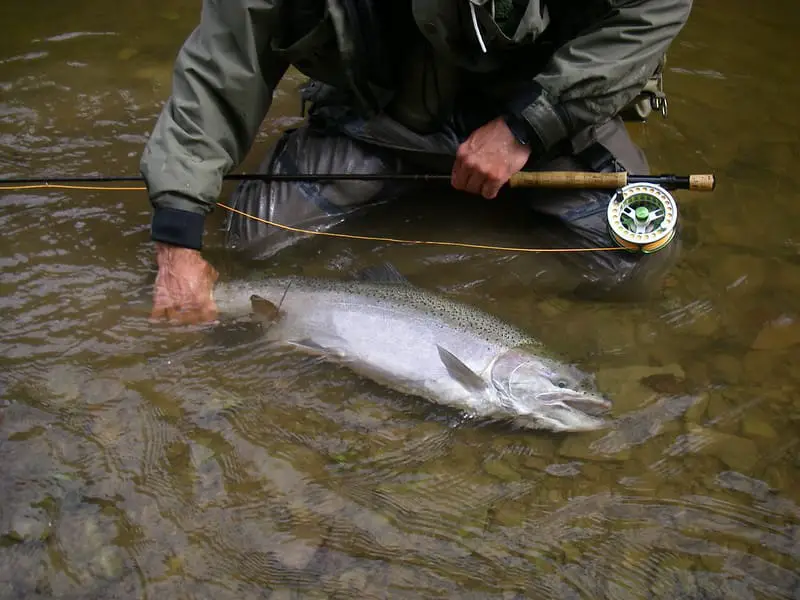
Since the streamers that we use for steelhead are not that big, a single-hand nine-foot, 7-weight fly rod is usually perfect most of the time under and in most river conditions. This size fly rod can also double as a nymphing rod, however, single-hand 10-foot fly rods are better when nymphing for steelhead.
I also use single-hand 9 foot 6 weight fly rods on smaller streams or when it’s not windy.
On larger open rivers where wind might be an issue or longer casts are required, I may use a single-hand nine-foot, 8-weight fly rod.
See Best Fly Rods For Steelhead Fly Fishing
Fly Reels For Steelhead Streamer Fishing
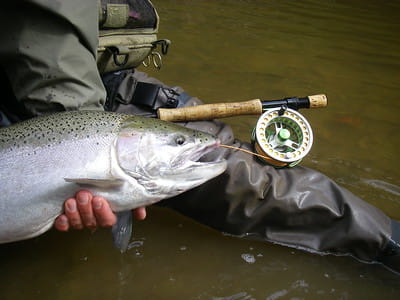
When it comes to reels, just about any large arbor fly reel with a good enclosed disc drag system will work.
Just be sure to match the reel and rod so it’s a balanced system.
Fly Line For Streamer Fishing
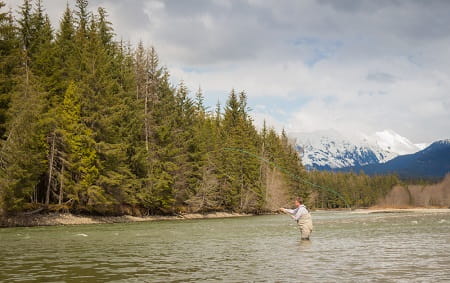
Any weight-forward floating fly line will work on water that is 3 to 6 feet deep.
You can also get good steelhead fly lines like the Orvis Hydros Salmon & Steelhead Fly Line or the RIO Specialty Series InTouch Salmo/Steelhead Fly Line.
However, there are some really good lines designed for streamer fishing that will help your casting and they might also make it easier and less work for you.
Streamer lines like the Orvis Hydros Floating Bank Shot lines or the Airflo Kelly Gallop Streamer line turn over big streamers with less effort.
With these floating lines you can add a poly leader to get your streamers to the desired depth. A 5 or 7-foot salmon/steelhead poly leader works great for getting your none weighted flies down. I’ll discuss these more below.
For deeper and faster water, some anglers prefer intermediate sink or full sinking lines. I would only use these if my rod was only for streamer fishing.
Leaders For Steelhead Streamer Fishing
There are two types of leaders that I use when steelhead streamer fishing.
A standard 7-foot or 9-foot tapered leader with a 12 to 24-inch tippet will work when fishing shallow water under 6 feet deep or with heavily weighted streamers. In bigger open rivers or clear water, the entire leader from line to fly should be 9 to 13 feet.
On smaller streams with a lot of trees and cover or hard to cast to places, a shorter 5 to 7-foot leader will work.
When I need to get my fly down three feet or more a good salmon/steelhead Poly Leader works well. These come in intermediate sink, to extra-fast sink rates.
Tippets For Steelhead Streamer Fishing
Tippet Type: The tippets I use are almost always Fluorocarbon, but regular Nylon/Mono tippets will also work. I prefer fluorocarbon because it sinks, is more invisible to the fish, and is more abrasion-resistant than Nylon/Mono tippets.
Tippet Strength: I recommend a tippet strength of 12 pounds for most steelhead rivers, or I use 14 to 16-pound tippets for very large fast rivers or when there is lots of wood or boulders that steelhead can get into.
Tippet Length: The length of the tippet I use on a standard tapered leader is about 12 to 18 inches.
Try the Seaguar STS Trout/Steelhead Fluorocarbon Leader Material
When using poly leaders, I will adjust the tippet length based on the clarity of the water and depth.
In clear water, I will use a 3 to 4-foot tippet. If the tippet is four feet or longer, the poly leader will sink and get deep, but the fly is so far from the weighted leader that it might still stay too high.
The shorter the tippet, the closer it is to the sinking poly leader and the deeper the fly will get.
However, most poly leaders are black, brown, or green so if the tippet is too short and the fly is too close to the poly leader, it could spook the fish. That is why I generally aim for about 3 feet of tippet.
In dirty water, clarity doesn’t matter as much so spooking the fish with the poly leader is less likely with a short tippet. Therefore, I will often use 2 to 3 feet to ensure it’s getting down.
The Leader Setup For Streamers
I will have a diagram for my leader setup soon. Until then, follow this steelhead streamer leader recipe.
Fly line – To Leader or Poly Leader – To tippet ( change length based on clarity and depth) – to the streamer fly
The Best Streamer Flies For Steelhead
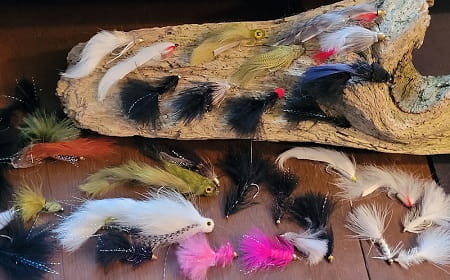
I use all kinds of streamer flies for steelhead fly fishing, and many of the flies I use are popular trout streamers.
When choosing a streamer consider the size of the streamer, its weight, and its color. Also, the water temperature and time of year can sometimes determine the streamer I use.
In colder water the fish can be less aggressive, for this reason, I will often use flies with good action at a slower retrieve. That’s why streamer flies with Maraboo are great for winter fishing.
Some of our guides will tell you to use smaller flies in cold water or in the winter, and some will say to go with big gaudy flies that get their attention. I say try both to see what they want because every river is different and day-to-day conditions can dictate what they want.
FYI, Streamer fishing in the winter is one of the things I discuss on my page Winter Steelhead Fly Fishing: 9 Tips From The Experts
Where in the river I am fishing can also dictate what streamer I will try first. If the river is shallow, a smaller streamer or a fat bulky streamer like a Zoo Cougar fly might work best because it’s going to get close to the fish, and bulky flies do not sink as well.
In deeper water, I may use a skinnier fly because skinny flies sink faster and get deeper.
I will also change my flies from the lower to the upper parts of the river.
The reason for this is that I have found that the steelhead that have just entered the river and are in the lower part of the river are usually very aggressive, and since they have been feeding on brighter bigger flashy baitfish out in the big water, they are more likely to take big bright colored and flashy streamers.
They will also take much bigger streamers than they would up the river. This is when white, silver, pink, or chartreuse streamers can work very well.
Once the steelhead have been in the river for a while and are way up the river, I tend to find that darker colors like black, black/purple, black/blue, and olive can be more effective. However, never count pink and white flies out, even way up the river.
Favorite Streamers For Steelhead
- Steelhead Bunny Leech – Good for all trout and steelhead and easy to tie
- Better wooly bugger (oversized and very bushy)
- White zonker fly for steelhead – Great for dead drifting
- Sex Dungeon – My favorite brown trout and steelhead stripping streamer fly
- Zoo Cougar – a good streamer for pocket water and shallower runs.
- Steelhead Marabou Muddler Minnow – Just oversize this fly with a longer marabou tail until it’s about 3 to 4 inches
- The Articulated Marabou Leech – One of my favorites from the great book The Complete Steelheader
- The Stupid Easy – One of my favorite lower river streamers
How To Retrieve Streamer Flies For Steelhead
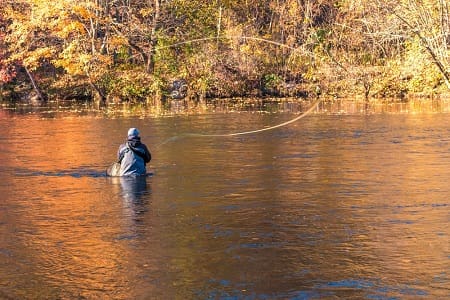
There are two ways to retrieve your streamers, and for some reason, everyone wants to do only one method.
That method is to cast across the river and just let the streamer swing across the pool without any stripping of the line. This is similar to Spey fishing, and it does work.
I didn’t know this when I was younger, so I fished steelhead the same way I did when fishing for trout. Catching trout with a stripping method worked best, and, as I found out, it works well for steelhead, too.
I didn’t realize I was doing it “wrong” or “different” from what other guys do until a client asked me to try streamer fishing for steelhead one day and I told him to strip the fly in.
A few years later, I met another guy who told me the top guide in the area also stripped streamers for steelhead, which made me feel a lot better about stripping streamers for steelhead. Especially since that guide was considered to be an exceptional fly guide.
Either way, casting or letting your fly swing across the pool, or stripping your fly works well. I will often try both, and on days when I get no action on a swung fly, I often get bites with an erratic retrieve from stripping in the fly.
I have with both trout and steelhead found that the more erratic i can make the fly, the more bites I will get. I try to make my streamer look like an injured or dying baitfish. This can be deadly on steelhead.
How Deep Does Your Streamer Need To Be?
Steelhead will often feed up when chasing baitfish so keeping your streamer fly over their heads is best.
In clear water I’m fine if my streamer is five feet over their heads, however, I always say the closer the better. This means I’d rather my streamer pass two feet over their head than 6 feet over their heads.
So, how deep? If I think the pool is 8 feet deep and the steelhead are on the bottom, I’ll try to get at least halfway down, which is 4 feet down.
If it’s only 4 feet deep, I only want my streamer one to two feet down.
In dirtier water when the steelhead sight is shorter, getting your fly within two feet is best. This means you need to get your streamer fly down and deep.
Where To Fish Your Streamer In The River – Covering The Water
To cover the water effectively I put my streamer in any water a steelhead might be holding.
For many anglers, they will only fish the deeper and bigger pools that are obvious steelhead spots. I will fish all the small pockets, riffles, runs, and pools.
In a small pocket that’s only 6 feet long, you might only need to make two casts. I would cast and retrieve the streamer at the very top right where it goes from shallow to deep, and then a second cast in the middle.
On longer spots, I will always start at the top of the spot and work my way down, casting and covering the water every 3 to 5 feet.
If the water is not very clear, I recommend a three-foot spread, and if it is, a five-foot spread.
Angles: Catching steelhead sometimes takes strategic thinking and the are fly fishing tactics that just work better. Understanding angles, both retrieve angles and the angle of your streamer can make a huge difference.
To cover the water effectively, cast across the river on a slightly downward angle and start your retrieve. The idea is you want your streamer to swing from the far bank to the close bank.
You do not want to cast straight down and retrieve the streamer straight up the river.
You also do not want to cast upstream and retrieve your streamer downstream. Many anglers will do this but this is likely the least effective direction to fish a streamer in a moving current. So, unless the water is still DON’T fish upstream if you actually want to catch steelhead.
The angle of your fly can also be very important. I have found that a streamer that is broadside to the fish works much better than if they see the tail or the fly coming head-on.
A fly broadside shows the fish the entire body and provides a large target for the steelhead which usually means more fish in the net.
To get a broadside angle I will often mend my line downwards and throw a big belly in the line so the fly swims more sideways to the current.
Throwing mends into a floating line is much easier, which is why I prefer to fly fish with a floating line and a sink tip versus a full sinking line. For the most part, floating lines make streamer steelhead fishing easier.
Casting Your Streamer: The Better Way
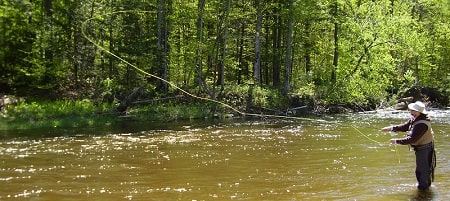
I promised I would tell you how to cover the water better, faster, and with less effort. This is something I teach in my advanced streamer fishing classes and it has made a huge difference in my student’s abilities to catch fish on a streamer.
In fact, I can cover 3 to 4 times more water in half the time as most anglers and with half the effort. This means I will put my fly in front of a lot more fish than other anglers in the same amount of time. And that means I catch more steelhead.
When most anglers fly fish they make multiple backcasts to get the fly far enough out. Personally, I feel most guys make too many back casts.
They also do this when throwing streamers, but it’s a lot harder to cast those big streamers, so making 3 or 4 back casts with a streamer each time can really tire you out.
I teach my clients how to cast streamers with one backcast. This means I cast once while another angler might cast 3 or 4 times.
You might be thinking, that’s not such a big difference, but for me to cast my fly 100 times it takes 100 casts, while the other guy will make 3oo or 400 casts to cover to get his fly out to the fish 100 times. This makes steelhead fishing much harder.
This means I use less effort and get my fly to the fish three times faster. I can effectively cover at least twice the amount of water at the same time as the other guy and that makes it easier to find fish.
How do I do this?
I don’t bring my fly in as close to the rod tip as the other anglers. I leave my fly at least 15 feet from my rod tip.
Meaning I don’t strip the fly in as close to my tip. Instead, I strip the fly all the way across the river and when I get to about 20 feet of line, I stop stripping line in and then twitch the tip of the rod to keep the fly moving and maintain the action.
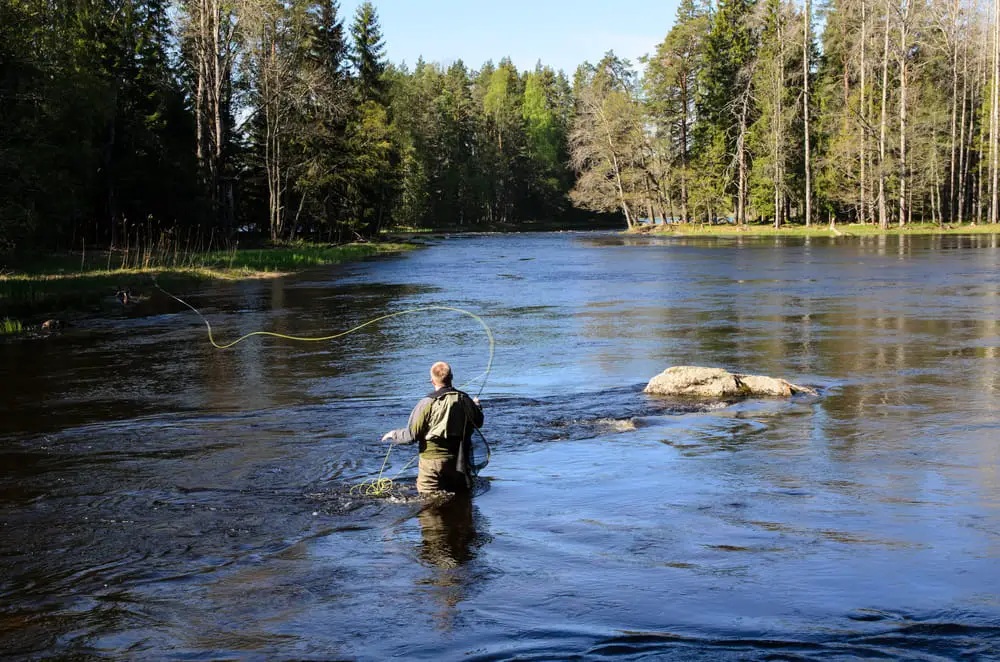
I then make a back cast up the river and as close to my bank as possible, let it hit the water, and then water load the next cast. Doing so allows me to make long casts of 40 or 50 feet of line in one power-forward cast.
This might be a little confusing which is why I will be doing a video to show you how.
This also works for swinging flies, and for fishing for salmon, brown trout, and rainbow trout.
Dead Drifting or Partial Dead Drifting Streamers
Yes, you can dead drift streamers, guys do this all the time when they nymph with Woolly Buggers and Egg-sucking Leech patterns. This is usually done with nymphing methods like indicator nymphing.
Tight Lines,
Graham

